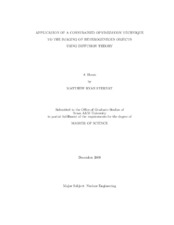Application of a Constrained Optimization Technique to the Imaging of Heterogeneous Objects Using Diffusion Theory
Abstract
The problem of inferring or reconstructing the material properties (cross sections)
of a domain through noninvasive techniques, methods using only input and
output at the domain boundary, is attempted using the governing laws of neutron
diffusion theory as an optimization constraint. A standard Lagrangian was formed
consisting of the objective function and the constraints to satisfy, which was minimized
through optimization using a line search method. The chosen line search
method was Newton's method with the Armijo algorithm applied for step length control.
A Gaussian elimination procedure was applied to form the Schur complement
of the system, which resulted in greater computational efficiency.
In the one energy group and multi-group models, the limits of parameter reconstruction
with respect to maximum reconstruction depth, resolution, and number of
experiments were established. The maximum reconstruction depth for one-group absorption
cross section or multi-group removal cross section were only approximately
6-7 characteristic lengths deep. After this reconstruction depth limit, features in the
center of a domain begin to diminish independent of the number of experiments.
When a small domain was considered and size held constant, the maximum reconstruction resolution for one group absorption or multi-group removal cross section is approximately one fourth of a characteristic length. When finer resolution then this
is considered, there is simply not enough information to recover that many region's cross sections independent of number of experiments or flux to cross-section mesh refinement.
When reconstructing fission cross sections, the one group case is identical to absorption
so only the multi-group is considered, then the problem at hand becomes
more ill-posed. A corresponding change in fission cross section from a change in
boundary flux is much greater then change in removal cross section pushing convergence
criteria to its limits. Due to a more ill-posed problem, the maximum reconstruction
depth for multi-group fission cross sections is 5 characteristic lengths, which
is significantly shorter than the removal limit.
To better simulate actual detector readings, random signal noise and biased noise
were added to the synthetic measured solutions produced by the forward models.
The magnitude of this noise and biased noise is modified and a dependency of the
maximum magnitude of this noise versus the size of a domain was established. As
expected, the results showed that as a domain becomes larger its reconstruction ability
is lowered which worsens upon the addition of noise and biased noise.
Subject
inverse neutron diffusioninverse problems
finite element
infer
reconstruct
Newton's method
multigroup neutron diffusion
optimization
Citation
Sternat, Matthew Ryan (2009). Application of a Constrained Optimization Technique to the Imaging of Heterogeneous Objects Using Diffusion Theory. Master's thesis, Texas A&M University. Available electronically from https : / /hdl .handle .net /1969 .1 /ETD -TAMU -2009 -12 -7311.


